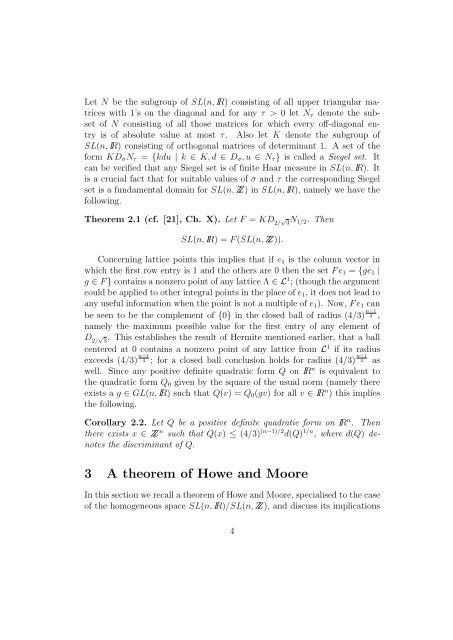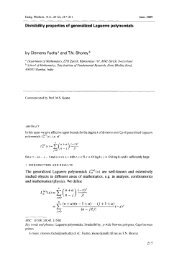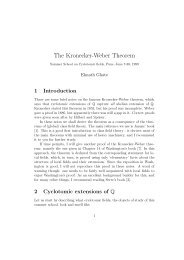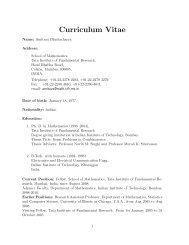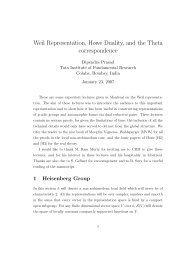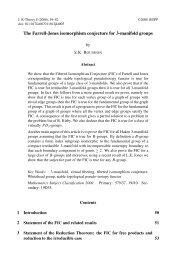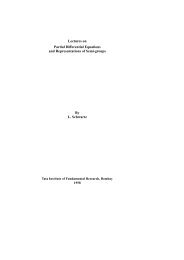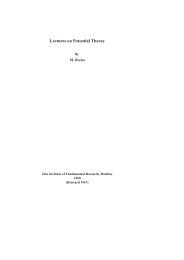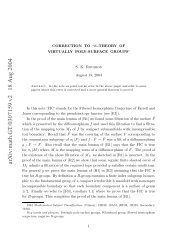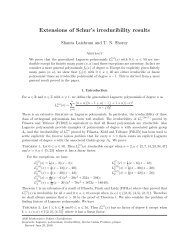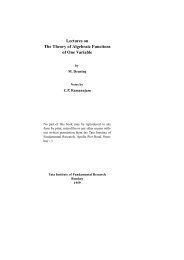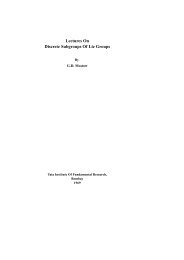On values of linear and quadratic forms at integral points
On values of linear and quadratic forms at integral points
On values of linear and quadratic forms at integral points
You also want an ePaper? Increase the reach of your titles
YUMPU automatically turns print PDFs into web optimized ePapers that Google loves.
Let N be the subgroup <strong>of</strong> SL(n, IR) consisting <strong>of</strong> all upper triangular m<strong>at</strong>riceswith 1’s on the diagonal <strong>and</strong> for any τ > 0 let N τ denote the subset<strong>of</strong> N consisting <strong>of</strong> all those m<strong>at</strong>rices for which every <strong>of</strong>f-diagonal entryis <strong>of</strong> absolute value <strong>at</strong> most τ. Also let K denote the subgroup <strong>of</strong>SL(n, IR) consisting <strong>of</strong> orthogonal m<strong>at</strong>rices <strong>of</strong> determinant 1. A set <strong>of</strong> theform KD σ N τ = {kdu | k ∈ K, d ∈ D σ , u ∈ N τ } is called a Siegel set. Itcan be verified th<strong>at</strong> any Siegel set is <strong>of</strong> finite Haar measure in SL(n, IR). Itis a crucial fact th<strong>at</strong> for suitable <strong>values</strong> <strong>of</strong> σ <strong>and</strong> τ the corresponding Siegelset is a fundamental domain for SL(n, Z) in SL(n, IR), namely we have thefollowing.Theorem 2.1 (cf. [21], Ch. X). Let F = KD 2/√3N 1/2 . ThenSL(n, IR) = F (SL(n, Z)).Concerning l<strong>at</strong>tice <strong>points</strong> this implies th<strong>at</strong> if e 1 is the column vector inwhich the first row entry is 1 <strong>and</strong> the others are 0 then the set F e 1 = {ge 1 |g ∈ F } contains a nonzero point <strong>of</strong> any l<strong>at</strong>tice Λ ∈ L 1 ; (though the argumentcould be applied to other <strong>integral</strong> <strong>points</strong> in the place <strong>of</strong> e 1 , it does not lead toany useful inform<strong>at</strong>ion when the point is not a multiple <strong>of</strong> e 1 ). Now, F e 1 canbe seen to be the complement <strong>of</strong> {0} in the closed ball <strong>of</strong> radius (4/3) n−14 ,namely the maximum possible value for the first entry <strong>of</strong> any element <strong>of</strong>D√2/ 3. This establishes the result <strong>of</strong> Hermite mentioned earlier, th<strong>at</strong> a ballcentered <strong>at</strong> 0 contains a nonzero point <strong>of</strong> any l<strong>at</strong>tice from L 1 if its radiusexceeds (4/3) n−14 ; for a closed ball conclusion holds for radius (4/3) n−14 aswell. Since any positive definite <strong>quadr<strong>at</strong>ic</strong> form Q on IR n is equivalent tothe <strong>quadr<strong>at</strong>ic</strong> form Q 0 given by the square <strong>of</strong> the usual norm (namely thereexists a g ∈ GL(n, IR) such th<strong>at</strong> Q(v) = Q 0 (gv) for all v ∈ IR n ) this impliesthe following.Corollary 2.2. Let Q be a positive definite <strong>quadr<strong>at</strong>ic</strong> form on IR n . Thenthere exists x ∈ Z n such th<strong>at</strong> Q(x) ≤ (4/3) (n−1)/2 d(Q) 1/n , where d(Q) denotesthe discriminant <strong>of</strong> Q.3 A theorem <strong>of</strong> Howe <strong>and</strong> MooreIn this section we recall a theorem <strong>of</strong> Howe <strong>and</strong> Moore, specialised to the case<strong>of</strong> the homogeneous space SL(n, IR)/SL(n, Z), <strong>and</strong> discuss its implic<strong>at</strong>ions4


